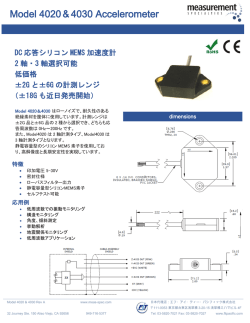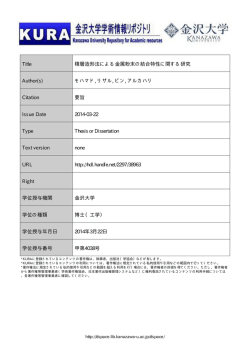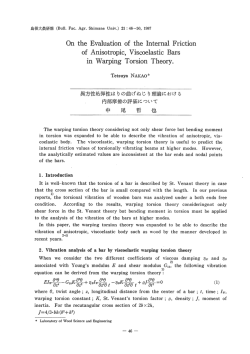
practice.Anewtest(TypeH:SCIDUandType皿:
島根大学地質学研究報告 14,15∼20ページ(1995年12月) GeoL Rept.Shimane Univ.,14,p.15∼20(1995) A simplified testing procedure f6r eva且uating the undrained shear behaviour of anisotropicaIly consolidated clay Takeshi Kamei* Abstract A simple procedure has been developed to estimate the undrained shear behaviour of anisotropically consolidated clay without special triaxial apparatus.The proposed testing procedure requires no special cell, and its simplicity,speed and economy are well suited to evaluate the undrained shear behaviour after Ko− consolidation.The comparison of data from three methods shows no significant difference in undrained shear behaviour evaluations.Finally,the experimental results obtained by the present method are found to be reasonable in engineering practice.The type H test can be readily used by practicing engineers.A1− thoughapPlicabletoonlyapa丘icularsoiltype,theprocedureapPearstobesufficientlyaccurateforprac− tical purposes. Key words:cohesive soil,consolidated undrained shear, earth pressure at rest, laboratory test, shear strength,test procedure. paratus which closely resembles that used in engineering Introduction practice.Anewtest(TypeH:SCIDUandType皿: Most commercial laboratodes conduct routine isotropi− SCIPCC)which can dramatically reduce the cost associ− cally−consolidated triaxial tests(CIU),whereas most in− ated with the undrained shear behaviour of Ko−consoli− situ natural clay deposits exist under anisotropic states of dated cohesive soils,is described in this paper.The ma− stress,corresponding to CAU conditions.Therefore,the jor advantage of this technique is its simplicity because mechanical behaviour of anisotropically cohesive soils it does not requires special triaxial apParatus.It also has have become of increasing importance as the number of a low initial cost and requires neither time measurement embankments and other earth stm、ctures being designed nor stress control during consolidation. and constructed on soft ground have increased.However, The purpose of this paper is to investigate whether it unless a device has specialized features as seen in Fig.1 is possible to estimate the undrained shear behaviour of (Nakase and Kamei,1983;Kamei,1985),Ko consolida− Ko−consolidated cohesive soil using standard triaxial ap− tion with no lateral strain is a difficult and time consum− paratus,and if so,how accurate these estimations are.Re− ing procedure to implement.In addition,the anisotropic sults using the proposed testing Procedures are presented consolidation phase of triaxial test specimens is generally and compared to data from special triaxial apparatus for time consuming and expensive,especially if Ko condi− Ko−consolidation. tions are maintained.It has also become standard proce− Experiments dure in CIU tests to use an effective confining Pressure equal to the estimated in situ vertical stress.Conse− Sample and testing Programme quently,it has become routine practice to consolidate the The undisturbed clay(Y−38)used in the present study specimens isotropically(Kc=1)before shear to failure. was sampled at16∼18m depth from a site south−west At this stage, it is advantageous to represent the of Tokyo Bay.The index properties of the soil sample is undrained shear behaviour of Ko−consolidated cohesive shown in Table 1.Fig.2shows the grading curve of the soils in a simple manner,using conventional triaxial ap一 specimen.All tests were consolidated undrained triaxial * Department of Geoscience,Shimane University, shear tests with pore pressure measurements. These 1060 Nishikawatsu, Matsue690,Japan. undrained shear tests were performed under strain−con一 15 Takeshi Kamei 16 舷ial load Lateral pressure Signa1(Axial disphcement) Control unit Axial displacement transducer 聯1↑ Benofヒam cylinder 鶴副 Floppy disk 一団團 Load cell Signa1(」咽al load) P’ t Lubrication Lateral Lεteral displac㎝1㎝t displa㏄m㎝t transdu㏄r hmsdu㏄r Pressure transducer ﹄o駕蓉。﹂o自︶ control㎜it 匙 Micro−computer ︵o﹄3沼目 田島あ Back pressure System Data soRware record Measurement signal Pore water pressure 副 measurement X−Y pbtter Measurement unit Printer Lateral displacement meas斑ement Fig.1Schematic diagram of automated Ko−consolidated triaxial apparatus. TablelIndexpropertiesofsoilstudied. Ps(9/cm3) 肌(%) ωP(%) 2,656 77.8 39.8 Sandσの 38 5 49 / Ko−Line/’ Clay(%) /ノ ρノ 46 6 ’ PI Silt(%) / ’ (1)Ko / nU O O O ΩU 6 4 ∩∠ ρ温州霞台おヨ㎏①蟹52£ ︵£エ︶σ 100 (q/P’・一定) ダ ,/ ,/ 、/ ノ/ / (H) / Is・・(0・67po) ノ ↓ / , D−Test YOKOHAMA Clay(Y−38) (皿) ISO.(PO) ↓ P’ニconst. 一Test 0.67pO Po PI=38 P’(kPa) 0 0.001 0.01 0.1 1 Fig.3Stress paths used in the present study. GminSize(mm) specimens,the effective confining Pressure was usually Fig.2Grain size distribution curve of sample. applied in one stress increment(0.67p。:SCIDU or p。: trolled during shear to failure.Fig.3 shows the stress SCIPCC), while for anisotropic consolidation, drained paths used in the present study.Three series triaxial tests shear and mean effective principal stress(pノ)at constant were prepared for each of the soils considered:Ko−con− were applied to the point of completion of Ko−consolida− solidated (Type I:CKoU) and anisotropically consoli− tion(qo)because of convenience and simplicity of the dated(Type H:SCIDU and Type皿:SCIPCC).The Type testing procedures(p。is the mean effective stress at the Hand Type皿proposed in the present study are conven− point of the completion of the Ko−consolidation,and q。 ience and simplicity of testing procedures for the evalu− is the principal stress difference at the point of the com− ation of the undrained shear behaviour of Ko−consoli. pletion of the Ko−consolidation).It is important to note dated cohesive soil,although Ko conditions are not main− that testing procedures used in this study are limited to tained dudng consolidation.For isotropically consolidated theevaluati・n・fundrainedshearbehavi・ur・fanisotr・pi一 A simplified testing procedure for evaluating the undrained shear 17 behaviourofanisotropicallyconsolidatedclay 1.0 0.8 0.6 0.4 Comp.Ext. 1 0> レb\ぴ H 0.2 個 品 』▲ 皿 0 一〇.2 一〇.4 一〇.6 0 10 20 ε (%) a Fig.4Comparisons of stress−strain behaviour obtained from three types of anisotropic consolidation process. Table2 Summary of triaxial test results. Initial Cond. ωnσ◎ 1 Comp. 一 一 一 dxt. Comp.一 一 一 一一一 一一 一 一一一一 eo 2.18 82.2一 一 一 一 一 一 一 一 甲 一 一 一 』 一 After Cons. ω・(%) 68.8 帰 需 − 囎 一 @ 79.9 ec 1.82 Tdaxial Test Results Kc 0.43輔 騨 騨 一 騨 層 一 響 − 一 一 一 暑 一 c。依Pの @ 2.13 67.9 2.08 @ 77.9 84.3 33900 @一18.19 30630 1.51 42550 26960 @ 〇.43 @ 78.8 66.9 1.78一 一 一 一 一 一 一 一 一 一 0.43一 一 一 昌 一 一 一 一 甲 − 一 卓 辱 一 114.〇一 一 一 一 一 一 一 一 一 軸 一 一 2.07 67.0 @1.78 @ 〇.43 @ 78.9 一17.89 2.24 66.1 0.43 117.3 0.85 47300 84.0 一18.87 Q9560 P.81 皿 Comp.一 一 一 一 一 一 畢 一 一 一 一 一 一 1.76一 一 雪 一 一 一 一 一 幽 一 一 一 一 一 一 一 一 』 一 一 一 一 一 @ Ext. @ 86.8 一 一 一 一 『 一 一 一 一 2.31 68.8 @ 1.83 Af 0.51一 一 一 一 − 一 昌 Cu/P 0.41一 一 一 幽 一 甲 一 ⇔ 一 一 一 一 一 一 一 一 H @ Ext. E50(kPの 1.04 116.3一 一 一 一 一 一 一 一 一 − 一 一 一 一 『 一 78.3一 一 一 一 督 一 一 一 一 − − 一 一 一 εf殉 @ 〇.43 0.80 @ 〇.28 0.56一 一 一 一 一 一 一 一 0.41, 一 榊 醤 一 一 岬 『 一 一 一 甲 一 Z.77 @ 〇.28 0.40一 一 一 』 一 一 一 一 一 』 一 } 一 輯 0.42} } 一 一 一 一 一 帰 一 一 一 一 一 @ 0.76 @ 〇.30 一 一 一 一 一 − 一 一 Takeshi Kamei 18 農品H IH皿 0.4 讐HH 0.6 の ・b\5ぐ 0.2 0 一〇.2 一〇.4 0 10 20 ε (%) a Fig.5Comparisons of excess pore pressure △u−strain behaviour obtained from three types of anisotropically consolidation process. cally consolidated cohesive soils only. iour obtained from three types of anisotropic consolida− A vertical effective consolidation pressure of 294 kPa tion process is shown in Fig.5,where the excess pore was used in the consolidation process.A back pressure pressure △u is no㎜alized by dividing by the vertical of l96kPa was applied to all the test specimens メ effective consolidation pressureσvc.As seen in this fig− throughout the consolidation and undrained shear. For ure,reasonable agreement is obtained from the excess each soil sample,triaxial compression and extension load− pore pressure △u−strain behaviour of undrained triaxial ings were pe㎡omed,with a constant rate of axial strain compression and extension loadings for undisturbed Yok− of O.07%/min.(Kimura and Saitoh,1983;Nakase and Ka− ohama clay(Y−38)su切ected to the three types of ani− mei,1986) Test results and discussions sotropic consolidation processes. Figure 6 compares the effective stress path results from three types of anisotropic consolidation processes, Figure4compares the stress−strain behaviour,results where the principal stress difference q=σa一σr and the obtained from three types of anisotropic consolidation メ ノ ノ mean effective stress p=(σa+2σr)/3are nomlalized by processes,where the principal stress difference q=σa一σr is dividingbytheverticaleffectiveconsolidationpressure normalized by dividing by the vertical effective consoli一 ノ ガ dation pressureσvcr.As seen in this figure,there is rea− ment between the results for effective stress paths of sonable agreement between results for stress−strain behav− undrained triaxial compression and extension loadings for iour of undrained triaxial compression and extension undisturbed Yokohama clay(Y−38)for the three types of loading for undisturbed Yokohama clay(Y−38),su切ected anisotropic consolidation processes considered.The proce− tothethreetypesofanisotropicconsolidationprocess. dureissufHcientlyvalidandaccurateforpracticalpur− Comparison of excess pore pressure △u−strain behav一 poses, and should be used to investigate the undrained σvc.As seen in this figure,there is reasonable agree− A simplified testing procedure for evaluating the undrained shear 19 behaviourofanisotropicallyconsolidatedclay 1.0 / ! / ・虜 ノ 勺 0.5 蕊 ./ ら / .窃 競ノ δ 鷲/ ノ/ O﹀ ・b\σ 1,/ ノ/ / ! 0 凪品H 讐HH IH皿 ゑ宅 ●も餐 q窒 一〇.5 0 0.5 1.O P亨/σ l VC Fig.6Comparisons of effective stress path obtained from three types of anisotropic consolidation process. shear behavlour of Ko−consolida,ted cohesive soil.The The author is fully aware of the limitations of the pro. type皿(SCIPCC)test,however,is time−consuming and posedtestingProcedure,anditshouldberegardedonly impractical for commercial testing.The weakness of this as a first apProximation. method lies in its neglect of the Ko conditions during Conclusions consolidation,however,a limitation that the type H ap− proach has overcome is to reduce the cost significantly. A simple procedure has been developed to estimate the The applicability of the proposed methods to other soils undrained shear behaviour of εmisotropically consolidated will constitute further research.Table2shows the sum− clay without special triaxial apparatus.The proposed tesレ maηゾOf triaXial teSt reSUltS. ing Procedure requires no special cell,and it is a simple, The combination of the proposed method and the shear rapid and economical way,to evaluate the undrained provide an extremely rapid,easy,reliable and economic shear behaviour after Ko−consolidation.The comparison means of evaluating the undrained shear behaviour of Ko of data from three methods shows no significant differ− −consolidated cohesive soils. ence in undrained shear behaviour evaluations.To this Takeshi Kamei 20 end,the experimental results obtained by the present degree of Doctor of Engineering. methods are found to be reasonable in engineering prac− Kim皿a,T.and Saitoh,K.,1983:The influence of strain tice.The type H test can be readily used by practicing rate on pore pressure in consolidated undrained triaxial engineers.Althoughrelevanttoonlyapa質icularsoil tests on cohesive soils,Soils and Foundations,Vol.23, type,theprocedureapPearstobesuf行cientlyaccuratefor No.1,80−90. practical purposes. Ladd,C.C.and Foott,R,1974:New design procedure Acknowledgement for stability of soft clays,Joumal of Geotechnical En− gineering Division,ASCE,Vol.100,No.7,763−786. The author would like to express his gratitude to Mr. Nakase, A. and Kamei, T., 1983:Undrained shear M.Hayashi,of Kiso−Jiban Consultants Co.,Ltd.for his strength anisotropy of nomally consolidated cohesive help during experimental work. soils,Soils and Foundations,Vol.23,No.1,91−101. References Kamei,T.,1985:A study on the mechanical behaviour of nomally consolidated cohesive soils,thesis pre− Nakase,A.and Kamei,T.,1986:Influence of strain rate on undrained shear characteristics of Ko−consolidated cohesive soils,Soils and Foundations,Vol.26,No.1,85 −95. sented to the Tokyo Institute of Technology,at Tokyo, Japan,in partial fulfillment of the requirements for the (要 旨) 亀井健史,1995.異方圧密粘土の非排水せん断挙動に関する簡便法の提案、島根大学地質学 研究報告,14. 自然地盤上に構造物を建設する際の破壊と変形のメカニズムを高精度に解析するために は,原位置での土要素の異方力状態を正確に再現したKo圧密状態からのせん断試験結果を 適用する必要がある.しかしながら,実務における三軸試験では三軸試験装置の機能・試験 者・コスト・試験時間の制約等の観点から,ほとんどの場合等方圧密条件下での試験が実施 されている. 上記の点に着目し,本研究では三種類の異方圧密過程の違いが,その後の非排水せん断特 性に及ぼす影響を検討している.その結果,通常の三軸試験装置を用いることによっても, 本研究で提案している応力経路を土要素に作用させることにより,異方圧密粘土の非排水せ ん断挙動を評価できることを示唆している.
© Copyright 2025



